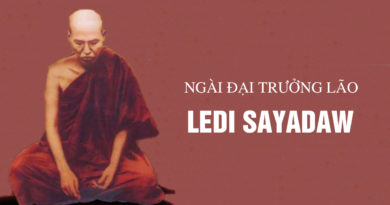A DISCOURSE ON THE ABODE OF THE NOBLE ONES – STAGES OF INSIGHT-KNOWLEDGE
A DISCOURSE ON THE ABODE OF THE NOBLE ONES – STAGES OF INSIGHT-KNOWLEDGE
In taking a step, the feeling of lightness as you lift your foot indicates tejo (heat) element, tenseness and motion as you put your foot forward indicate vaayo (wind) element, the heaviness as you put the foot downward is aapo element while the friction and resistance at the moment of the impact of the foot on the ground reflect pathavi (earth) element. Thus the distinctive features of each of the four primary elements is evident. Whenever you observe the behaviour of your body, you distinguish between the body which does not know its sense-object and the mind which knows it. This is insight into the distinction between mind and matter.
Later on as concentration develops, the yogi becomes more aware of the nature of the phenomenal world. He finds that when he bends his hand, the bending is preceded by the desire to bend; that seeing arises on account of the eye and the visible object; that hearing, etc., are due to the corresponding sense-organs and sense-objects. It takes only a few days practice of mindfulness to realize that every phenomenon is made up of cause and effect, that there is no ego, person or being who creates it.
Then the yogi knows analytically the beginning and end of each unit of psycho-physical phenomenon. The beginning is the arising and the end is the vanishing of an event. As he observes this ceaseless process of arising and vanishing, the yogi realizes the law of impermanence. Impermanence is the mark of the five khandhaa’s or mind-body complex. It has two aspects, viz., the arising from a state of non-existence and coming into a state of momentary existence; and vanishing and passing away into a state of momentary existence and then into a state of non-existence.
This arising and passing away is the sign of impermanence. If a thing does not arise at all, it cannot be called impermanent. Such a thing implies the concept of Nibbaana which has no origination. Nor can we call a thing impermanent if it arises and exists forever. But there is no such things. Everything that has a beginning has also an end.
The insight into the law of impermanence leads the yogi to realize dukkha (suffering) and anatta (insubstantiality of life). These three marks of existence are intertwined and whenever we see anatta, we are close to Nibbaana. But there “seeing” anatta means not mere intellectual acceptance but insight-knowledge born of meditation.
After having insights into impermanence, etc., the yogi ceases to reflect and keeps on noting the psycho-physical phenomena. Then his consciousness deepens. He discriminates sharply between the beginning and the end of every phenomenon. He sees illumination and experiences joy, rapture, serenity, an upsurge of faith and heightened awareness. But the yogi should not mistake these blissful states for the peace of Nibbaana. He should note and overcome them.
Then as he continues to practise mindfulness, there comes a time when his consciousness is confined to ceaseless vanishing. When he contemplates an object, he no longer thinks of its shape or size or quality. He sees everything, the object,his mind, etc., passing away ceaselessly. This is called bhanga~naa”na.
Because the yogi sees everything passing away, he is seized with fear (bhaya~naa”na).
Fear leads to recognition of the evils of conditioned existence (aadinavaa~naana). So the yogi becomes sick of life (nibbida~naana). Because of his disillusionment, he wants to be free (mu~ncatukamyata~naana) and to achieve his object he has to resort to special contemplation (patiankhaanaa”na). This results in the full comprehension of the three signs of existence, viz., anicca, dukkha and anatta (sankhaanupekkha~naa”na).
With the emergence of this insight, the yogi attains equanimity in regard to the six sneses, which the Buddha describes follows:
– “O monks, the monk who has seen a visible object with his eyes is neither pleased nor displeased. His mind is in equilibrium, being affected neither by attachment nor by aversion. This is because he has right mindfulness.”
Note that the Paa.li text refers to the monk who has seen the object. It makes no sense to speak of a yogi’s equanimity in the absence of sense-objects that attract or repel him. In point of fact he is unperturbed in the face of sense-objects and this is due to his right mindfulness and insight into the nature of conditioned existence with its chief characteristics of anicca, dukkha and anatta.
“Cakkhunaa ruupa”m disvaa ….Having seen the object, the monk recognizes it with clear or right understanding.” Right understanding caues neither pleasure nor displeasure: it makes the yogi completely indifferent in his contact with the external world. This is the special attribute of the Arahat and as the commentary says, it is possible for the yogi to possess it. He can have it when he attains all the successive stages of insight-knowledge through whole-hearted effort.
Some teachers of meditation tend to mis-lead their disciples by exaggerating the importance of their lectures. The yogi should not accept their words blindly. He should not regard himself, say, as a sotaapanna, on the authority of his teacher. Instead, he should examine himself on the basis of his experience and the Buddha’s teaching. If he is a true sotaapanna, his experience leaves no doubt about the three signs of conditioned existence, the nature of Nibbaana and the other teachings of the Buddha. So he has unshakeable faith in the Buddha, the Dhamma and the Sangha. He also strictly avoids killing, stealing, indulging in illicit sex, lying and drinking.
These then are the four essential attributes of a sotaapanna and this teaching of the Buddha can help the yogi to decide whether he has attained the first stage on the path. A real sotaapanna has no desire to do evil. His moral life does not need self-restraint since it is spontaneous. In this respect he differs from the false sotaapanna whose morality is superficial and prone to back-sliding.









